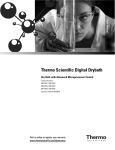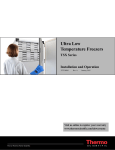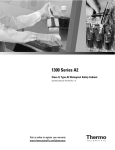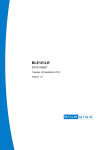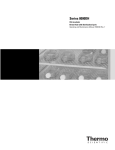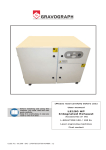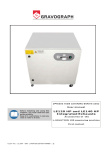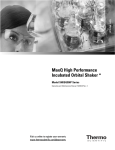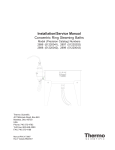Download Midi 40 Series CO2 Incubator
Transcript
User Manual Midi 40 Series CO2 Incubator Operating and Maintenance Manual 7003403 Rev. 7 Visit us online to register your warranty www.thermoscientific.com/labwarranty Preface Models covered by this manual: Model 3403 115V Model 3404 208/230V MANUAL NUMBER 7003403 7 30073/IN-4491 7/7/15 Added stacking hardware kit to Parts List ccs 6 30073/IN-4491 7/28/14 Clarified specs in Location for stacking ccs 5 26439/IN-4050 2/5/13 Updated uniformity in Specifications ccs 4 28251/IN-4219 8/30/12 Removed RS-485 ccs 3 28728 6/18/12 Updated Calibration sections - pg 6-4 through 6-6 ccs 2 27796/IN-4127 10/3/11 Tubing size from 3/16 to 1/4” - pgs 4-1 and 4-3 ccs -- -- 6/10/10 Corrected typo in Table 6-1 on pg 6-2 - removed O2 (per D. Wernerspach) ccs -- -- 3/22/10 Clarifications and corrections to pg 1-2 table dims ccs 1 26174 2/18/10 Clarifications and corrections per N. Pisani (corrected reversed ext cm dims 3/17) ccs 0 -- 12/1/09 Original, was 33602H01 Rev. A ccs REV ECR/ECN DATE DESCRIPTION By Thermo Scientific Midi 40 CO2 Incubator i Preface CAUTION Contains Parts and Assemblies Susceptible to Damage by Electrostatic Discharge (ESD) Important Read this instruction manual. Failure to read, understand and follow the instructions in this manual may result in damage to the unit, injury to operating personnel, and poor equipment performance. s Caution All internal adjustments and maintenance must be performed by qualified service personnel. s Material in this manual is for information purposes only. The contents and the product it describes are subject to change without notice. Thermo Fisher Scientific makes no representations or warranties with respect to this manual. In no event shall Thermo be held liable for any damages, direct or incidental, arising out of or related to the use of this manual. ©2009 Thermo Fisher Scientific. All rights reserved. ii Midi 40 CO2 Incubator Thermo Scientific Preface Important operating and/or maintenance instructions. Read the accompanying text carefully. Potential electrical hazards. Only qualified persons should perform procedures associated with this symbol. Equipment being maintained or serviced must be turned off and locked off to prevent possible injury. Hot surface(s) present which may cause burns to unprotected skin, or to materials which may be damaged by elevated temperatures. Marking of electrical and electronic equipment, which applies to electrical and electronic equipment falling under the Directive 2002/96/EC (WEEE) and the equipment that has been put on the market after 13 August 2005. This product is required to comply with the European Union’s Waste Electrical & Electronic Equipment (WEEE) Directive 2002/96/EC. It is marked with the WEEE symbol. Thermo Fisher Scientific has contracted with one or more recycling/disposal companies in each EU Member State European Country, and this product should be disposed of or recycled through them. Further information on Thermo’s compliance with this directive, the recyclers in your country and information on Thermo Scientific products will be available at www.thermofisher.com. 4 Always use the proper protective equipment (clothing, gloves, goggles, etc.) 4 Always dissipate extreme cold or heat and wear protective clothing. 4 Always follow good hygiene practices. 4 Each individual is responsible for his or her own safety. Thermo Scientific Midi 40 CO2 Incubator iii Preface Do You Need Information or Assistance on Thermo Scientific Products? If you do, please contact us 8:00 a.m. to 6:00 p.m. (Eastern Time) at: 1-740-373-4763 1-800-438-4851 1-740-373-4189 http://www.thermo.com [email protected] Direct Toll Free, U.S. and Canada FAX Internet Worldwide Web Home Page Service E-Mail Address Our Sales Support staff can provide information on pricing and give you quotations. We can take your order and provide delivery information on major equipment items or make arrangements to have your local sales representative contact you. Our products are listed on the Internet and we can be contacted through our Internet home page. Our Service Support staff can supply technical information about proper setup, operation or troubleshooting of your equipment. We can fill your needs for spare or replacement parts or provide you with on-site service. We can also provide you with a quotation on our Extended Warranty for your Thermo Scientific products. Whatever Thermo Scientific products you need or use, we will be happy to discuss your applications. If you are experiencing technical problems, working together, we will help you locate the problem and, chances are, correct it yourself...over the telephone without a service call. When more extensive service is necessary, we will assist you with direct factory trained technicians or a qualified service organization for on-the-spot repair. If your service need is covered by the warranty, we will arrange for the unit to be repaired at our expense and to your satisfaction. Regardless of your needs, our professional telephone technicians are available to assist you Monday through Friday from 8:00 a.m. to 6:00 p.m. Eastern Time. Please contact us by telephone or fax. If you wish to write, our mailing address is: Thermo Scientific Controlled Environment Equipment 401 Millcreek Road, Box 649 Marietta, OH 45750 International customers, please contact your local Thermo Scientific distributor. iv Midi 40 CO2 Incubator Thermo Scientific Table of Contents Thermo Scientific Section 1 Introduction . . . . . . . . . . . . . . . . . . . . . . . . . . . . . . . . . . . . . . . . . . . . . . . . .1-1 Requirements . . . . . . . . . . . . . . . . . . . . . . . . . . . . . . . . . . . . . . . . . . .1-1 Specifications . . . . . . . . . . . . . . . . . . . . . . . . . . . . . . . . . . . . . . . . . . .1-2 Section 2 Safety Precautions . . . . . . . . . . . . . . . . . . . . . . . . . . . . . . . . . . . . . . . . . . .2-1 Section 3 Operating Standards . . . . . . . . . . . . . . . . . . . . . . . . . . . . . . . . . . . . . . . . . .3-1 Section 4 Pre-Installation . . . . . . . . . . . . . . . . . . . . . . . . . . . . . . . . . . . . . . . . . . . . . .4-1 Included Parts . . . . . . . . . . . . . . . . . . . . . . . . . . . . . . . . . . . . . . . . . .4-1 Location . . . . . . . . . . . . . . . . . . . . . . . . . . . . . . . . . . . . . . . . . . . . . . .4-2 Set-Up . . . . . . . . . . . . . . . . . . . . . . . . . . . . . . . . . . . . . . . . . . . . . . . .4-2 Wiring . . . . . . . . . . . . . . . . . . . . . . . . . . . . . . . . . . . . . . . . . . . . . . . .4-2 Gas Supplies . . . . . . . . . . . . . . . . . . . . . . . . . . . . . . . . . . . . . . . . . . . .4-2 CO2 Gas Connections . . . . . . . . . . . . . . . . . . . . . . . . . . . . . . . . . . .4-3 Component Locations . . . . . . . . . . . . . . . . . . . . . . . . . . . . . . . . . . . .4-4 Section 5 Initial Start-Up Procedures . . . . . . . . . . . . . . . . . . . . . . . . . . . . . . . . . . . .5-1 Start-Up Prompts . . . . . . . . . . . . . . . . . . . . . . . . . . . . . . . . . . . . . . . .5-1 Power / Key Switch . . . . . . . . . . . . . . . . . . . . . . . . . . . . . . . . . . . . . .5-1 Setpoint Parameters . . . . . . . . . . . . . . . . . . . . . . . . . . . . . . . . . . . . . .5-1 Section 6 Key Switch and Control Operation . . . . . . . . . . . . . . . . . . . . . . . . . . . . .6-1 Restore Function . . . . . . . . . . . . . . . . . . . . . . . . . . . . . . . . . . . . . . . .6-3 Service Mode Parameters . . . . . . . . . . . . . . . . . . . . . . . . . . . . . . . . . .6-3 Setpoint and Alarm Programming . . . . . . . . . . . . . . . . . . . . . . . . . .6-3 Calibration (Optional) . . . . . . . . . . . . . . . . . . . . . . . . . . . . . . . . . . . .6-4 Access Program or Service Menu . . . . . . . . . . . . . . . . . . . . . . . . . .6-4 Temperature Calibration . . . . . . . . . . . . . . . . . . . . . . . . . . . . . . . . .6-5 CO2 Calibration . . . . . . . . . . . . . . . . . . . . . . . . . . . . . . . . . . . . . . .6-6 Midi 40 CO2 Incubator v Table of Contents vi Midi 40 CO2 Incubator Section 7 Control Systems Theory . . . . . . . . . . . . . . . . . . . . . . . . . . . . . . . . . . . . . . .7-1 Overtemperature Monitoring System . . . . . . . . . . . . . . . . . . . . . . . . .7-1 CO2 Recovery (after door opening) . . . . . . . . . . . . . . . . . . . . . . . . . .7-2 CO2 Control System . . . . . . . . . . . . . . . . . . . . . . . . . . . . . . . . . . . . .7-2 Door Heat System . . . . . . . . . . . . . . . . . . . . . . . . . . . . . . . . . . . . . . .7-2 Section 8 Maintenance . . . . . . . . . . . . . . . . . . . . . . . . . . . . . . . . . . . . . . . . . . . . . . . .8-1 CO2 Filter Replacement . . . . . . . . . . . . . . . . . . . . . . . . . . . . . . . . . .8-2 Cleaning . . . . . . . . . . . . . . . . . . . . . . . . . . . . . . . . . . . . . . . . . . . . . . .8-2 Door Seal Check . . . . . . . . . . . . . . . . . . . . . . . . . . . . . . . . . . . . . . . .8-3 Fuses . . . . . . . . . . . . . . . . . . . . . . . . . . . . . . . . . . . . . . . . . . . . . . . . .8-3 Section 9 Parts List . . . . . . . . . . . . . . . . . . . . . . . . . . . . . . . . . . . . . . . . . . . . . . . . . . . .9-1 Section 10 Warranty Information . . . . . . . . . . . . . . . . . . . . . . . . . . . . . . . . . . . . . . . .10-1 Thermo Scientific Section 1 Introduction These incubators are designed to create a stable, reliable environment for cell culture applications. They operate at temperatures ranging from 5°C above ambient temperature to +60°C, accurate to ±0.2°C. The gas system controls within ±0.1% of measurable setpoint. • Thermal conductivity sensor provides stable, automatic injection of CO2. • Automatic Gas Shutoff control turns off the gas supply when the inner glass door is opened to prevent wasting the control gas. • Alarms: – High and low level CO2 setpoint alarms, adjustable. – High and low temperature alarms; high alarm can be set by user. – Battery Low alarm; control system has tested the alarm battery and determined that it should be replaced. Caution The function of the alarm battery is to operate the display and alarm system ONLY during a power loss, while the key switch is in the On or Alarm position. This battery system will not power the heaters, fan motor or gas control system. Only qualified service technicians should replace this battery. Replacement instructions and batteries are available from Thermo Scientific. s Requirements • A high quality two-stage, low pressure 15 psig (1.056 kg/cm2) pressure regulator is required for proper operation of the CO2 gas supply. • In-line gas supply filters must be used on the CO2 supply to prevent damage to the solenoid valve(s): – Type: Microbiological – Specification: 0.3 micron – Location: rear of unit • Thermo Scientific CO2 used in the incubator must be at least 99.9% pure. Midi 40 CO2 Incubator 1-1 Section 1 Introduction Specifications Technical Specifications Model 3403 Model 3404 Dimensions Exterior (w x h x d) inch/cm 23.5 x 18 x 18.5 (59.7 x 45.7 x 47) Interior (w x h x d) inch/cm 14 x 14 x 12 (35.5 x 35.5 x 30.5) Construction Cabinet configuration Interior Benchtop non-corrosive stainless steel, type 304, mirror finish Interior volume Chamber capacity 1.4 cu ft (39.6 l) Shelves 4 Construction stainless steel, perforated Shelf dimensions (w x d ) inch/cm 13.5” x 11.5” (34.3 x 29.2) Surface area per shelf 1.08 sq ft (0.1 sq m) Temperature Range 5°C above ambient to 60°C Control ±0.1°C Uniformity Alarm ±0.5°C @ 37°C user programmable high/low CO2 Range 0-20% Control ±0.1% Sensor long life thermal conductivity sensor Uniformity Inlet pressure required 0.10% 15 PSIG (1.0 bar), 99.5 medicinal grade CO2 Inlet air filtration 0.3 micron anti-microbial filter Alarm user programmable high/low Humidity rH Source to 95% @ 37°C humidity pan, removable Electrical Rated voltage 115V, 60Hz 208/230V, 50/60Hz Amps/breaker 1.5/15 1.0/15 Weight Net 60 lbs. (27kg) Shipping 70 lbs. (32kg) Warranty 1 year All specifications are subject to change without notice. 1-2 Midi 40 CO2 Incubator Thermo Scientific Section 2 Safety Precautions In this manual and on labels attached to this product, the words WARNING and CAUTION mean the following: • WARNING: a potentially hazardous situation which, if not avoided, could result in serious injury or death. • CAUTION: a potentially hazardous situation which, if not avoided, may result in minor or moderate injury or damage to the equipment. The following symbols are used in caution, warning and informational labels attached to the incubator: caution, info on electrical hazard off hot surface alternating current earth ground protective conductor terminal Figure 1-1. Symbols Used in Labels on Incubator Before installing, using or maintaining this product, please be sure to read this manual and product warning labels carefully. Failure to follow these instructions may cause this product to malfunction, which could result in injury or damage. Thermo Scientific Midi 40 CO2 Incubator 2-1 Section 2 Safety Precautions Below are important safety precautions that apply to this product: • Use this product only in the way described in the product literature and in this manual. Before using it, verify that this product is suitable for its intended use. • Do not modify system components, especially the controller. Use OEM exact replacement equipment or parts. Before use, confirm that the product has not been altered in any way. • Disconnect the unit from all power sources before cleaning, troubleshooting, or performing other maintenance on the product or its controls. To disconnect power supply to the incubator, unplug the supply cord at the back of the incubator. Note that turning the key switch on the front control panel to the Off position is not sufficient to disconnect power. Warning The user is responsible for carrying out appropriate decontamination procedures when hazardous materials are spilled on or inside the incubator. s 2-2 Midi 40 CO2 Incubator Thermo Scientific Section 3 Operating Standards The incubators described in this manual are classified for use as stationary equipment in a Pollution Degree 2 and Overvoltage Category II environment, according to the UL3101-1 and IEC 664 standards. These units are designed to operate under the following environmental conditions: Thermo Scientific • Indoor use • Altitude up to 2000m • Maximum relative humidity 80% for temperatures up to 31°C • Main supply voltage fluctuations not to exceed 10% of the nominal voltage. Midi 40 CO2 Incubator 3-1 Section 4 Pre-Installation At delivery, examine the exterior for physical damage while the carrier’s representative is present. If exterior damage is present, carefully unpack and inspect the unit and all accessories for damage. If there is no exterior damage, unpack and inspect the equipment within five days of delivery. If you find any damage, keep the packing materials and immediately report the damage to the carrier. Do not return goods to the manufacturer without written authorization. When submitting a claim for shipping damage, request that the carrier inspect the shipping container and equipment. Included Parts The following items are packaged and shipped inside the incubator cabinet: • This manual • Shelves and shelf brackets • 1/4 in. (6.35 mm) ID clear tubing for the gas connection • Cordset • 5” round humidity pan • Additional CO2 sensor gasket • CO2 disposable filter 99.97 Filter Additional gasket Operating manual Humidity pan Cordset Tubing Figure 4-1. Included Components (shelves and brackets not shown) Thermo Scientific Midi 40 CO2 Incubator 4-1 Section 4 Pre-Installation Set-Up Location Remove shelves from the inside of the incubator and clean the chamber. Shelves and brackets can be autoclaved. Install the unit in a level area free from vibration with a minimum of three inches (7.6 cm) of space on the sides and rear, and twelve inches (30.5 cm) at the top. The floor must be able to support 40 PSI (single chamber incubator) or 75 PSI (stack of two incubators with the addition of stacking hardware kit). Be sure to position the incubator so that the power cord (mains disconnect) is easily accessible to disconnect power. Do not position the equipment in direct sunlight or near any HVAC duct/diffusers. The ambient temperature range at the work location must be 59 to 90°F (15 to 32°C). Gas Supplies Verify that the incubator CO2 gas supplies are available near the installation area. The required gas supply pressure is 15 PSI, controlled by a high-quality, two-stage regulator suitable for the connected input gas. Warning Do not connect the gas at this time. Wiring s Caution Connect the equipment to the correct power source. Be sure to operate the incubator at the voltage specified on the dataplate. Incorrect voltage can result in severe damage to the equipment. s Warning For personal safety and trouble-free operation, this unit must be properly grounded before it is used. Failure to ground the equipment may cause personal injury or damage to the equipment. Always conform to the National Electrical Code and local codes. Do not connect the unit to overloaded power lines. s The incubators described in this manual are available with the following volatages: 115VAC, single-phase, 60Hz, 3A and 208/230VAC, single phase, 50/60Hz, 2A Be sure to check your dataplate to verify the correct voltage for your unit. Always connect the unit to a dedicated (separate) circuit. Do not exceed the electrical and temperature ratings printed on the dataplate located near the upper hinge of the unit. Electrical codes require fuse or circuit breaker protection for branch circuit conductors. Use time delay fuses for #12 AWG circuits. 4-2 Midi 40 CO2 Incubator Thermo Scientific Section 4 Pre-Installation CO2 Gas Connections CO2 gas connection(s) are located at the rear of the unit. Note The required gas supply pressure is 15 PSI. Make sure the supply is available in the installation area. s To install the CO2 connections, complete the following steps: 1. Locate the included 1/4 in. (6.3mm) interior diameter tubing. 2. Cut a small length (approximately 6 in. [15cm]) from the roll of 1/4 in. (6.3mm) ID tubing. 3. Pull the cap off the gas connection port at the rear of the incubator and attach one end of the tubing to the gas connection port. 4. Connect the opposite end of the tubing to a high-quality input gas filter (0.3 micron supplied). Note that the side of the filter marked “IN” faces the incoming gas connection, not the back of the incubator (refer to Figure 1-2). 1/4 in. ID Tubing Gas Filter Figure 1-2. CO2 Gas Connections 5. Use the remaining 1/4 in. ID tubing to connect the input gas to the gas filter. Keep the tubing length as short as possible to minimize the pressure drop. Caution DO NOT turn on the gas supply at this time. s Thermo Scientific Midi 40 CO2 Incubator 4-3 Section 4 Pre-Installation Component Locations dataplate on left side Inside Chamber sensor humidity pan Lower back of unit Upper back of unit Sample Port Power inlet CO2 inlet 4-4 Midi 40 CO2 Incubator Thermo Scientific Section 5 Start-Up Prompts Initial Start-Up Procedures On first start-up of the incubator, the control display will go through several prompts to guide you through the entire set-up process, from leveling the incubator to adjusting the operating parameters. During normal operation, the control panel display looks like Figure 5-1. The next section explains all the control functions available during normal operation. On initial start-up, however, a series of prompts displays. This section explains the start-up prompts and the procedures to follow. Power / Key Switch TEMP (C) 37.0 CO2 (%) 5.0 Turn the key switch (shown in Figure 5-1) to the “1” position. Press and hold the up arrow button to initiate the special start-up prompts. If a temperature displays instead of a start-up prompt, the up arrow button hasn’t been held long enough. Turn the key switch back to “O” and try again. key switch O Setpoint Parameters I A prompt displays to accept or adjust the values of several operating parameters. In each case, press the up or down arrow buttons (increase or Figure 5-1. Control Panel decrease) to change a displayed value. Press Mode when the displayed value is the one desired. The modifiable value is always the one flashing. If a displayed parameter is not adjusted and 60 seconds elapse, the software registers the existing default value and moves to the next parameter. If no changes are needed to the factory-set defaults, press Mode repeatedly until the end of the prompts. Thermo Scientific Midi 40 CO2 Incubator 5-1 Section 5 Initial Start-Up Procedures Setpoint Parameters (continued) The adjustable parameters are: • Temperature (default 37ºC) • Warm alarm (default 40ºC; cannot deviate from the temperature setpoint by less than 0.3ºC) • Cold alarm (default 34ºC; cannot deviate from the temperature setpoint by less than 0.3ºC) • CO2 (default 5%) • High CO2 alarm (default 6%; cannot deviate from the CO2 setpoint by less than 1%) • Low CO2 alarm (default 4%; cannot deviate from the CO2 setpoint by less than 1%) When parameter adjustments are complete, the screen returns to the normal display (Figure 5-1). An additional message indicates that the stabilization period has begun. During this initial stabilization period, leave the door closed. 5-2 Midi 40 CO2 Incubator Thermo Scientific Key Switch and Control Operation Section 6 To operate the incubator with alarms activated, be sure to turn the key switch all the way to the rightmost position (as shown in Figure 6-1). To avoid nuisance alarms, work with the key switch in the “I” position during the set-up procedures described in Section 5. TEMP (C) The control panel is located on the front of your incubator. 37.0 Before loading and using your incubator, be sure to take some time to review the control panel functions. The main display, during normal operation, shows: cabinet temperature in degrees Celsius, as measured by the sensor inside the cabinet; and percentage levels of carbon dioxide (CO2). When one or more of these fields flashes during normal operation, an alarm or error condition is indicated. Note that alarm conditions are displayed only when the key switch is turned to the alarm position. CO2 (%) 5.0 UP ARROW (INCREASE) MODE DOWN ARROW (DECREASE) O I KEY SWITCH Figure 6-1. Key Switch Thermo Scientific Midi 40 CO2 Incubator 6-1 Section 6 Key Switch and Control Operation In programming mode (described in detail in Table 61) the main display changes to show the setpoint being viewed and related alarm setpoints. For example (Figure 6-2): Set Temp SETPOINT: 37.0C 40.2C The first value displayed is the temperature setpoint; 33.8C the next two values are the high temp alarm and low temp alarm setpoints. The flashing value is one that can be changed, using the up and down arrow buttons. Figure 6-2. Programming Mode The up and down arrow buttons are used to change setpoint values in programming mode and for various display functions. The Mode pushbutton is used: to silence an audible alarm; to enter programming and service modes; and in combination with the other buttons for various display functions. For full descriptions of display, programming, and service functions, refer to Tables 6-1, 6-2, and 6-3. Table 6-1. Control Panel Display Function Meaning Sequence Normal operation Default display while incubator is running Cold excursion Show coldest cabinet temperature since last startup or reset Press Display shows cold excursion while button is pressed. Warm excursion Show warmest cabinet temperature since last startup or reset Press Display shows warm excursion while button is pressed. Mode Silence audible alarm Press Mode Display shows current values, alarm or error field continues to flash. Reset Return to default display after excursion or alarm condition Press and simultaneously Excursion values are reset; display shows current values. Display flashes twice 6-2 Midi 40 CO2 Incubator — Display Display shows cabinet temperature, CO2, Relative Humidity. Thermo Scientific Section 6 Key Switch and Control Operation Setpoint and Alarm Programming To enter Program mode, press and hold the MODE button until the display indicates it is changing to Program mode. Press Mode repeatedly to scroll through the available functions. Exit Program mode by scrolling through all available functions and parameters using the Mode button, or the display will automatically return to normal operating mode 30 seconds after the last key entry. Table 6-2. Setpoint and Alarm Programming Functions Function Programming Sequence Adjust temperature setpoint Enter programming mode by pressing Mode and holding for 5 seconds. On release, the current temperature setpoint value flashes in the display; use and to adjust it. Adjust warm alarm setpoint Press Mode again. The current warm alarm setpoint value then flashes in the display; use and There is a minimum deviation of 0.3º C between each alarm setpoint and the temperature setpoint. to adjust it. Adjust cold alarm setpoint Press Mode again. The current cold alarm setpoint value then flashes in the display; use and to adjust it. There is a minimum deviation of 0.3º C between each alarm setpoint and the temperature setpoint. Adjust CO2 setpoint Press Mode again. The display changes to display CO2 setpoint and high and low CO2 alarm setpoints, with the and to adjust it. There is a minimum deviation of 1% between each operating CO2 setpoint flashing. Use alarm setpoint and the operating CO2 setpoint. Adjust CO2 high alarm setpoint Press Mode again. The current high CO2 alarm setpoint then flashes; Use and to adjust it. There is a minimum deviation of 1% between each alarm setpoint and the operating CO2 setpoint. Adjust CO2 low alarm setpoint Press Mode again. The current high CO2 low setpoint then flashes; Use and deviation of 1% between each alarm setpoint and the operating CO2 setpoint. to adjust it. There is a minimum Set Temp offset Press Mode again. The display changes to display temperature offset (for calibration purposes). Use adjust it. and Set CO2 offset Press Mode again. The display changes to display CO2 offset (for calibration purposes). Use to adjust it. Service Mode Parameters and to Service mode can be entered from Program mode by pressing Mode and holding for 5 seconds.Pressing Mode repeatedly scrolls through the available functions. For any modifiable parameter, the up and down arrow buttons can be used to adjust the value. The display automatically returns to normal operating mode 30 seconds after the last key entry, or after scrolling through all available functions and parameters. Table 6-3. Service Parameters Parameter Notes SN Serial number. Check Sum Checksum to identify firmware version PWM Info CO2 sensor and excursion information Restore Function When the incubator is first powered up, all factory-set program parameter defaults can be restored as follows: Table 6-4. Restore Defaults Function Restore program defaults Thermo Scientific Sequence simultaneously, Press and hold for five seconds Notes Restores original (factory-set) values of all program parameters. Midi 40 CO2 Incubator 6-3 Section 6 Key Switch and Control Operation Calibration (Optional) The Midi-40 Incubator utilizes a Thermal Conductivity (TC) CO2 sensor. This style of CO2 sensor is adversely affected by changes in temperature and relative humidity (RH). Therefore it is necessary to verify the temperature calibration first and then wait for the passive RH inside the chamber to stabilize, after any adjustment is made to temperature settings. It is recommended that a full CO2 calibration procedure be performed: • After replacing the CO2 sensor or main micro board. • If, after re-setting a CO2 calibration offset and the offset calibration does not improve the true measured accuracy. • If the interior RH condition is changed by adding or removing the RH water pan to convert from a wet to dry condition. Caution The full zero/span calibration procedure requires the user to access the Program and Service Mode menu. s Access Program or Service Menu To access the Service Mode, you first must enter Program mode. Press and hold the Mode key for approximately five seconds until “Program Mode;” is displayed. Release the key. Next press and hold the Mode key again for approximately six seconds until “Service Mode;” is displayed. Release the key. Note If user does not push any keys after approximately thirty seconds, the display will revert back to the normal Run mode . If a value was changed, whatever value was last displayed will be stored as the new setting. 6-4 Midi 40 CO2 Incubator Thermo Scientific Section 6 Key Switch and Control Operation Temperature Calibration 1. Ensure shelf support system and empty shelves are in place 2. Fill humidity pan approximately halfway full with distilled water and position the RH pan on the incubator chamber floor and centered. 3. Install reference temperature sensor into the geometric center of the chamber ensuring the sensor is not touching any shelves and is measuring air temp only. Note There is no access port located on a Midi-40 incubator to permit passing cables through. Therefore a user must pass their independent calibration temperature sensor cable through the inner and outer door gasket seal. If access to a flat or thin style cable is not available, this may lead to humidity escaping the inner chamber thus causing condensation to form on the glass door or between the inner and outer doors surfaces. If a thin style cable is not available, attempt to seal around the cable using some perma-gum style putty (part # 13014) to help seal the passing of the cable through the door gasket seal. 4. After power is connected, turn key switch from (0) to (I) On position. 5.) To set or adjust the Temp setpoint, enter Program mode. The first menu is “Set Temp Setpoint”. Using the increment up arrow or the decrement down arrow, adjust setting to desired temperature. Continue to press the Mode button to advance from menu to menu to exit, or wait 30 seconds and system will default to normal Run menu. 6. Set CO2 control set point in Program mode to 0.0% to keep CO2 injection solenoid off. It is highly recommended NOT to connect the CO2 supply at this time. 7. Allow for temperature to stabilize; a. Start-Up - Allow 12 hours for the temperature in the cabinet to stabilize before proceeding. b. Operating Unit - Allow at least two hours after the display reaches setpoint for the temperature to stabilize before proceeding. 8. Enter Program Mode, go to “Set Temp OFFSET” option and press the up/down arrow to match the display to a calibrated instrument. 9. For any offset adjustments made, allow at least 1 hour between adjustments to permit the unit to stabilize again. 10. After the temperature is calibrated, it is recommended to remove the temp sensor from the inner chamber to ensure the humidity inside the chamber is not passing through the door seal. TC CO2 sensors require stable temp and RH environment to ensure accurate calibration! Thermo Scientific Midi 40 CO2 Incubator 6-5 Section 6 Key Switch and Control Operation CO2 Calibration 1. After performing the Temperature calibration first, ensuring the unit has stabilized and the outer and inner door has not been opened for at least two hours, proceed to zero the CO2 sensor. 2. Enter the Program mode, press Mode key until “Set CO2 OFFSET” is displayed. Using the increment or decrement keys, make offset read 0.0%. Exit Program mode back to normal Run mode. 3a. Enter the “Service Mode”, press Mode key until “Zero CO2TC Sensor” is displayed. Press the decrement key to zero, then press the increment key to accept. The display should read zero micro-volts (0uV). IMPORTANT NOTE You must complete the next step to fully zero the CO2 sensor! s 3b. Press the increment key to set the new zero micro-volt (uV) value and then press the decrement key to accept. Repeat this step until you get repeating micro-volt values that are within ±50uV of each other. If the uV values are greater than 50 digits, this indicates that the Temp/RH has not fully stabilized inside the chamber and you should wait longer for the Temp/RH to stabilize. 4. In “Service Mode”, press the Mode key again to display “Span CO2TC Sensor”. Adjust CO2 span to read 975uV. 5. Press Mode key to exit Service mode, or wait 30 seconds for auto exit. 6. Connect CO2 supply and ensure CO2 gas pressure is set at 15psig, set CO2 setpoint to desired setpoint, e.g. 5.0%. 7. Allow system to stabilize at least 1 hour after unit display shows set point. Ensure that no door openings occur during this stabilization period. 8. Just before taking a CO2 gas sample with your CO2 calibration handheld meter or FYRITE, lower the CO2 control set point in Program mode 1.0% below your current set point, e.g. from 5% to 4%. This step is necessary to prevent CO2 gas injection during the calibration of the unit. 6-6 Midi 40 CO2 Incubator Thermo Scientific Section 6 Key Switch and Control Operation CO2 Calibration (continued) IMPORTANT NOTE During the sampling of the chamber with your FYRITE or hand-held calibration meter, the CO2 value shown on the unit display will most likely drop a few tenths of a percent from e.g. 5% CO2 to maybe 4.5%, depending on how many FYRITE measurements/ aspirations you take, or depending on how long you leave your hand-held calibration meter aspiration pump running. It is recommended that you take 2-3 FYRITE measurements and or leave your CO2 hand-held meter sampling the interior chamber for approx 1.5 to 2 minutes but no greater than 3 minutes. After obtaining your calibration readings, remove the tubing from CO2 sample port and cap the port. Allow the unit CO2 displayed value to stabilize, waiting approximately 3 minutes before proceeding with the CO2 calibration offset in the next step! 9. Enter Service Mode, press Mode key until “Span CO2TC Sensor” is displayed. Using the increment or decrement keys, adjust the span until the correct CO2 % level is indicated. 10. Press Mode key to exit Service Mode, or wait 30 seconds for auto exit. 11. To verify if the new CO2 calibration works correctly, open both outer and inner doors for at least 30 seconds, close the doors and wait a minimum of two hours permitting the temperature and RH to stabilize. 12. After two hours, sample the CO2 via the sample port with calibration instrument; remember to reduce CO2 set point 1.0% below your actual set point to avoid injecting gas during your measurement check. 13. If a small offset adjustment between (0.1 to 0.5%) is necessary, enter Program mode, press Mode key until “Set CO2 OFFSET” is displayed. Using the increment or decrement keys, enter a corresponding offset to match the displayed value with your calibration instrument. Press Mode key to exit Program mode, or wait 30 seconds for auto exit. CO2 OFFSET NOTE If a CO2 offset value was entered, after exiting Program mode back to the normal Run mode; wait at least 2 to 3 minutes for the displayed value to auto-correct using the new offset value entered. The delay in the update is due to how the system microprocessor averages CO2 measurements, the displayed value will not update immediately! s Thermo Scientific Midi 40 CO2 Incubator 6-7 Section 7 Control Systems Theory Laboratory CO2 Incubators have a “jacket” between the incubator chamber and the exterior wall of the unit. In water jacketed incubators, the jacket is filled with water; in dry wall incubators, the jacket contains air. The temperature control system operates in the same manner for both types of incubators. Interior chamber temperature control is maintained by two sensors. One sensor is located in the jacket and the other sensor is located in the chamber air. Both sensors constantly signal the electronic circuitry. The chamber air provides a reference point while the jacket is being controlled. This circuitry recognizes that jacket temperature is very slow to react to any change in either ambient or chamber temperature but the chamber temperature can change very rapidly due to door opening. For example: The chamber inner door is opened. The chamber air sensor immediately signals a large drop in temperature but the control recognizes that, unless there is a corresponding (smaller) drop in jacket temperature, there is no need to increase the heat. The system does nothing until sufficient time passes to measure how fast the chamber air temperature is rising to meet the jacket temperature after the door is closed. Heat is applied to the jacket in short bursts. The rate of heat application changes as the circuit monitors the two sensors. This control scheme is extremely accurate and stable, with the ability to control within ±0.1°C of the setpoint. Overtemperature Monitoring System Thermo Scientific This system is activated anytime the chamber air sensor detects a temperature above the overtemperature setpoint, which should be set no closer than 0.3°C above the chamber temperature. When the system is activated, the jacket heater is turned off and both audio and visual alarms are activated. Control is now effectively switched to the overtemperature monitoring system. The overtemperature sensor is the chamber air sensor which also provides the signal for the digital display on the control panel. Midi 40 CO2 Incubator 7-1 Section 7 Control Systems Theory Door Heat System 7-2 Heating the inner surface of the outer door with a low wattage, large area heater provides enough radiant heat to the glass door to control condensation. The micro-processor control operates the door heater. CO2 Control System This system uses a sensor assembly consisting of a pair of matched, thermistor sensors in a housing. One of the sensors is sealed in a nitrogen filled housing and provides the 0 to 1 VDC reference signal for the gas control board. The other sensor continually samples filtered chamber air. The main control board compares these signals with the input from the control panel CO2 setpoint. If the difference exceeds 0.5% below setpoint, the CO2 solenoid remains open 100% of the time. If the difference is less than 0.5%, the CO2 solenoid cycles until setpoint is reached. CO2 Recovery (after door opening) When the chamber inner door is opened, the door switch shuts off all gas flow into the chamber. When the door is closed, gas again flows into the chamber under the control of the TC gas concentration sensor. At this time the gas solenoid is open 100% of the time and remains open until the CO2 level has recovered to within 5% of the setpoint. The solenoid then reverts to cycling. Midi 40 CO2 Incubator Thermo Scientific Section 8 Maintenance Warning Maintenance procedures involve working with high voltages which can cause injury or death. Maintenance should only be performed by trained personnel. s The incubator can be easily cleaned and disinfected in about 30 minutes. Be sure to use an appropriate disinfectant solution: Roccal II; its Lysol equivalent, 5 milliliters per liter; or O-Syl in a one percent solution. Disinfectants should always be diluted with sterile, distilled water. Caution Before using any cleaning or decontamination method except for those recommended in the manufacturer, contact Technical Services to verify that you will not damage the equipment. s Caution Do not use strong alkaline or caustic agents, which can cause corrosion, rust and pitting of stainless steel surfaces. Stainless steel is corrosion-resistant but not corrosion-proof. s Caution Do not use sodium hypochlorite solutions such as Purex and Clorox. These can also cause corrosion and pitting of stainless steel. s Caution Do not use steel wool pads such as Brillo; they deposit carbon particles in the chamber. s When cleaning stainless steel, use the mildest cleaning procedure that will do the job effectively. To avoid marring the surface, always rub in the direction of the finish polish lines. Caution Do not use aromatic solvents to clean the cabinet interior: residues could cause contamination of the cabinet environment. s Thermo Scientific Midi 40 CO2 Incubator 8-1 Section 8 Maintenance Cleaning To clean and disinfect your incubator: 1. Remove the shelves, support walls and pans. 2. Clean all interior surfaces with the disinfectant solution using a clean sponge. 3. Rinse the interior surfaces at least twice with sterile distilled water. 4. Clean the inner door gasket thoroughly. 5. Clean the inside of the glass door with the disinfectant solution, then rinse twice with sterile distilled water. 6. Clean the shelves, support walls and pans with disinfectant and rinse thoroughly with sterile distilled water. 7. Wipe down all disinfected surfaces with an alcohol solution. Caution Alcohol is volatile and flammable. Use only in a well-ventilated area removed from open flames and other heat sources. Allow sufficient time for fumes to dissipate before using cleaned components. s CO2 Filter Replacement To replace the CO2 Filter: 1. Turn the main power switch to OFF. 2. Turn the gas supply (or supplies) to OFF. 3. Remove the tubing from both ends of the gas filter. 4. Note the flow direction on the filter. The side marked IN points to the gas supply. Install the new filter onto the tubing connected to the incubator and the tubing connected to the gas supply (refer to Gas Supplies in Section 4 and Figure 3-1). 5. Turn the gas supply (or supplies) to ON. 6. Turn the main power switch to ON. 8-2 Midi 40 CO2 Incubator Thermo Scientific Section 8 Maintenance Fuses The fuses used in this incubator are located on the power supply board and should only be replaced by a qualified technician. The F1 and F2 fuses are Type “T”, rated at 120V/6A or 230VAC/3A. The F3 and F4 fuses are Type “T”, rated at 120V/500mA or 230VAC/300mA. Door Seal Check To check the door seal, complete the following steps: 1. Open the inner glass door. 2. Insert a strip of paper (a couple of inches wide) between the door gasket and the cabinet flange and close the door. 3. Slowly pull the paper strip from the outside. You should feel some resistance. 4. Repeat this test at 4 inch (10 cm) intervals around the door. If the door does not seal properly, call Technical Services; the gasket needs to be adjusted or replaced. Thermo Scientific Midi 40 CO2 Incubator 8-3 Section 9 Thermo Scientific Parts List Description Part Number Door Gasket, Inner Assy (8 ft) 103140 MIDI Door Heater 115V 132073 MIDI Chamber Heater 115V 132083 MIDI Door Heater 230V 132113 MIDI Chamber Heater 230V 132121 MIDI Control Panel Overlay 140393 SYMPHONY Control Panel Overlay 140394 MIDI Display Assembly SRO 192039 MIDI Micro Board SRO 192040 MIDI, Power Board 120V SRO 192041 MIDI, Power Board 230V SRO 192042 MIDI CO2 Incubator Decal (VWR) 220881 MIDI Inc Decal (SYMPHONY) 220882 MIDI RTD Temp Sensor 1000HM 290194 MIDI CO2 Sensor Assembly 290195 MIDI EPROM Programmed 320546 MIDI Inc Power To Micro Harness 350061 MIDI Inc Door Switch and Harness 350062 MIDI Incubator Key Switch and Harness 350064 MIDI, Lead-Acid Battery 12V 400194 Cordset 10A/125V,18/3,USA 430108 Cordset 10A,250V, European 430109 2 Black Rubber Suction Type Foot 505180 Disposable Filter 99.97 770001 MIDI Exterior Door Gasket 990044 MIDI Inner Glass Door SRO 1900435 MIDI Inner Door Latch SRO 1900436 Valve Assembly, CO2 Solenoid SRO 1900437 Stacking Hardware Kit 290225 Midi 40 CO2 Incubator 9-1 Thermo Scientific Midi 40 CO2 Incubator 10-1 Rev. 4 4/09 REGISTERED ISO 9001 If equipment service is required, please call your Technical Services Department at 1-800-438-4851 (USA and Canada) or 1-740-373-4763. We're ready to answer your questions on equipment warranty, operation, maintenance, service and special application. Outside the USA, contact your local distributor for warranty information. Your local Thermo Sales Office is ready to help with comprehensive site preparation information before your equipment arrives. Printed instruction manuals carefully detail equipment installation, operation and preventive maintenance. THIS WARRANTY IS EXCLUSIVE AND IN LIEU OF ALL OTHER WARRANTIES, WHETHER WRITTEN, ORAL OR IMPLIED. NO WARRANTIES OF MERCHANTABILITY OR FITNESS FOR A PARTICULAR PURPOSE SHALL APPLY. Thermo shall not be liable for any indirect or consequential damages including, without limitation, damages relating to lost profits or loss of products. Replacement or repair of components parts or equipment under this warranty shall not extend the warranty to either the equipment or to the component part beyond the original warranty period. The Technical Services Department must give prior approval for return of any components or equipment. At Thermo's option, all non-conforming parts must be returned to Thermo Fisher Scientific postage paid and replacement parts are shipped FOB destination. During the first year, component parts proven to be non-conforming in materials or workmanship will be repaired or replaced at Thermo's expense, labor included. Installation and calibration are not covered by this warranty agreement. The Technical Services Department must be contacted for warranty determination and direction prior to performance of any repairs. Expendable items, glass, filters and gaskets are excluded from this warranty. The Warranty Period starts two weeks from the date your equipment is shipped from our facility. This allows for shipping time so the warranty will go into effect at approximately the same time your equipment is delivered. The warranty protection extends to any subsequent owner during the first year warranty period. THERMO FISHER SCIENTIFIC STANDARD PRODUCT WARRANTY 10-2 Midi 40 CO2 Incubator Thermo Scientific Rev. 4 2/09 REGISTERED ISO 9001 Contact your local distributor for warranty information. We’re ready to answer your questions on equipment warranty, operation, maintenance, service and special application. Your local Thermo Sales Office is ready to help with comprehensive site preparation information before your equipment arrives. Printed instruction manuals carefully detail equipment installation, operation and preventive maintenance. THIS WARRANTY IS EXCLUSIVE AND IN LIEU OF ALL OTHER WARRANTIES, WHETHER WRITTEN, ORAL OR IMPLIED. NO WARRANTIES OF MERCHANTABILITY OR FITNESS FOR A PARTICULAR PURPOSE SHALL APPLY. Thermo shall not be liable for any indirect or consequential damages including, without limitation, damages relating to lost profits or loss of products. Replacement or repair of components parts or equipment under this warranty shall not extend the warranty to either the equipment or to the component part beyond the original warranty period. The Technical Services Department must give prior approval for return of any components or equipment. At Thermo's option, all non-conforming parts must be returned to Thermo postage paid and replacement parts are shipped FOB destination. During the first year, component parts proven to be non-conforming in materials or workmanship will be repaired or replaced at Thermo's expense, labor excluded. Installation and calibration are not covered by this warranty agreement. The Technical Services Department must be contacted for warranty determination and direction prior to performance of any repairs. Expendable items, glass, filters, reagents, tubing, and gaskets are excluded from this warranty. The Warranty Period starts two months from the date your equipment is shipped from our facility. This allows for shipping time so the warranty will go into effect at approximately the same time your equipment is delivered. The warranty protection extends to any subsequent owner during the first year warranty period. Dealers who stock our equipment are allowed an additional six months for delivery and installation, provided the warranty card is completed and returned to the Technical Services Department. THERMO FISHER SCIENTIFIC INTERNATIONAL DEALER WARRANTY thermoscientific.com © 2014 Thermo Fisher Scientific Inc. All rights reserved. All trademarks are the property of Thermo Fisher Scientific and its subsidiaries. Specifications, terms and pricing are subject to change. Not all products are available in all countries. Please consult your local sales representative for details. Thermo Fisher Scientific 401 Millcreek Road Marietta, Ohio 45750 United States A Thermo Fisher Scientific Brand






































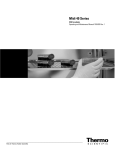
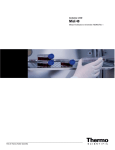
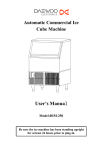
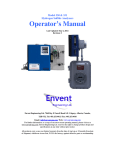
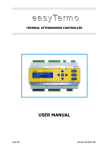

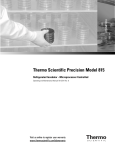
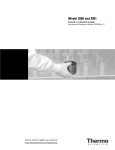
![TSD Series -40C ULT User Manual [EN]](http://vs1.manualzilla.com/store/data/005634658_1-66c9db561a67486106446026c707a26c-150x150.png)
